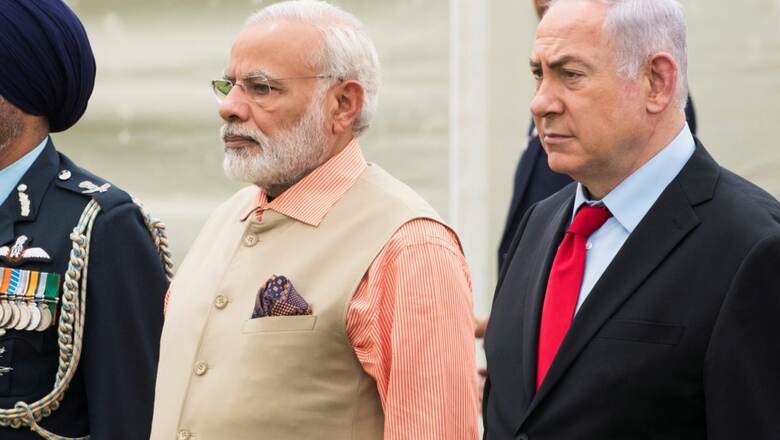
views
The war in Gaza, forced upon as a result of a brutal terror attack by Hamas on 7 October 2023, has taken a heavy toll on innocent civilians on both sides. Responding to the Hamas terror attack, which killed 1,400 Israeli citizens including children, infants, women and elderly, Israel regrouped quickly and unleashed a ferocious assault into Gaza, coined as ‘Operation Iron Swords’. In over 45 days of the war, Israel has conducted over 7,500 strikes by air and artillery, moved ground troops and tanks into Gaza cutting off Northern Gaza and has caused heavy destruction in the Gaza Strip. The Red Cross and the Palestinian Health Ministry have reported that the death toll in Gaza has already crossed 14,500 which includes more than 6,000 children.
Israel’s insistence on ‘flattening Gaza to the ground’ and ‘eliminating Hamas from the face of the earth’ has meant that it has not exercised any restraint while choosing targets and striking them irrespective of the heavy collateral damage and casualties it may cause. Its strikes on hospitals in Gaza, UN-run facilities, schools and refugee camps have caused global outrage and calls for an immediate ceasefire, and access to humanitarian aid is growing louder by the day. The WHO, UN Relief and Works Agency, UN Population Fund and UNICEF put out a joint statement on 4 November stating that almost 420 children are being killed or injured in Gaza every day.
The UN General Assembly, in its special session on 27 October, adopted a resolution sponsored by Jordan, calling for an “immediate, durable and sustained humanitarian truce”. It also demanded “continuous, sufficient and unhindered” provision of lifesaving supplies and services for civilians trapped inside the enclave. On 4 November, US Secretary of State Blinken undertook his second visit to Israel in the past month and advised Prime Minister Benjamin Netanyahu against punitive strikes causing death and destruction of civilians and reiterated an appeal for a humanitarian pause so that essential aid could be delivered to the suffering population. On 15 November, the UN Security Council too passed a resolution, sponsored by Malta, calling for “urgent and extended humanitarian pauses and corridors throughout the Gaza Strip” to allow for aid delivery and medical evacuations.
Special meetings of BRICS and OIC too have asked for early ceasefire and delivery of humanitarian aid. All regional countries including Saudi Arabia, UAE, Iran and others have unequivocally condemned Israeli strikes causing mass civilian casualties. The Arab Islamic Committee, a joint delegation of Arab and Muslim nations comprising ministers of Saudi Arabia, Egypt, Jordan, and the Palestinian Authority, is on a global tour to rally support for a ceasefire and has already visited China on 20 November and Paris on 22 November.
Amidst all this, pressure is mounting on Israel to exercise restraint and permit the delivery of humanitarian aid. Despite that, on 17-18 November, Israel struck two schools in Northern Gaza including one run by UNRWA leading to over 50 deaths, mostly children and over 200 severely injured coupled with absolute destruction of the school facilities. Once again, it was promptly condemned by the UN and regional countries. Meanwhile, on 22 November, Israel’s cabinet gave the go-ahead to a hostage exchange of 50 hostages comprising women and children in exchange for the release of 150 Palestinian prisoners and a four-day ceasefire, which has been mediated by Qatar. However, till it happens, Israel is continuing with its punitive strikes.
As the people in Gaza and the world look ahead with hope at a possible ceasefire, Israel too could use this pause and ask itself some critical questions. In 45 days of war, how much has Israel been successful in eliminating Hamas? By asking people to evacuate Northern Gaza earlier and southern Gaza now, what is the end game that Israel is looking for in Gaza? Is Israel looking for Gaza as a ‘Death Zone’ where there will be no living population, as a possible scenario in Gaza? Can Israel, at the end of this war, give credible assurance to its citizens that the Hamas terror threat has been eliminated for good? What about the complete destruction of the famed tunnel network of Hamas in Gaza?
With the raid and blockade of Al Shifa Hospital in Gaza not being able to provide conclusive evidence that the hospital and the tunnels behind were actually being used by Hamas as command centres, how does Israel justify the deaths of hundreds of children and patients there due to lack of critical medical care, leading to their burial in mass grave in hospital’s backyard? Has Israel achieved its military and political objectives or is it still a work in progress? More importantly, does an end state of this war leave any space for a two-state solution which ensures a viable and independent state of Palestine?
There are many more questions, with very few concrete answers. Herein lies an opportunity therefore for Israel to look beyond its borders and seek answers to at least some of these questions. Like Israel, India too has grappled with the threat of terror for the last three decades and the manner in which India has slowly but steadily brought about peace and stability, especially in Kashmir valley, could hold some answers for Israel.
Indian Lessons for Israel
While India got its independence in August 1947, the state of Israel was formed in May 1948. Both nations had to face armed conflicts shortly thereafter, in 1948. While the ceasefire in the case of Israel resulted in it occupying additional territory than what was earmarked as its national boundaries, India had to accept the division of territory in Jammu & Kashmir with one part of Kashmir going under Pakistan’s occupation.
Both nations fought major wars later too, Israel in 1967 and 1973 while India fought wars against Pakistan in 1965, 1971 and 1999 (Kargil War) and in 1962 against China. There have been other minor conflicts in which both nations have fought against their adversaries, including their fight against terror unleashed on them from across the borders. Also, both nations have adversaries who use ‘terror as an instrument of state policy’. Both nations have also faced hostage and hijack situations endangering the lives of their citizens, more than once.
However, the methods and strategies used by India and Israel in countering these threats differ vastly. While India has always exercised restraint and has mostly avoided crossing the borders or Ceasefire line or Line of Control, (LoC) with Pakistan, Israel has been more aggressive in its methods used in countering its threats. While India has propagated peaceful co-existence and has made several attempts to make peace, Israel too, while offering peace solutions, has usually followed a strategy of seeking ‘peace through security’ and has often taken the battle right into enemy territory.
India, which has been fighting terror since 1990 in Jammu & Kashmir, mostly emanating from Pakistan, had to deploy a large amount of security forces to counter it. Like Israel, in fact, learning from Israel, India came up with a ‘Line of Control Fence’ which acts as a physical barrier for terrorists infiltrating into India. Surveillance sensors coupled with active military deployment on the fence have ensured that infiltration levels have dropped significantly in the past decade.
In the early decades of fighting terror in Kashmir valley, India was confronted with a situation where the terrorists (local and foreign) enjoyed support from the locals making the task of security forces difficult. However, India exercised restraint and followed the strategy of minimum force to achieve the objectives. India has also not been known for the use of air strikes to target terror groups hiding amongst civilian population, and definitely never any strikes on hospitals, schools, UN facilities etc, on either side of LoC.
While conducting operations within the Indian side of Kashmir, Indian forces have exercised utmost restraint to ensure minimum collateral damage, even at a great loss to its own soldiers sometimes. India has never enforced any blockades that prevented the delivery of critical humanitarian and medical aid to people in the region. On the contrary, ‘Operation Sadbhavana’, a campaign launched by the Indian Army in the early 2000s to win the hearts and minds of people in Kashmir, has been hugely successful in winning back the support of locals in Kashmir and alienating the terrorists.
At the height of the Kargil war in 1999 too, when India was taking heavy casualties due to challenges posed by the enemy and terrain, India did not cross the LoC by ground or air to conduct operations. This may have dealt a tactical disadvantage militarily but the strategic advantage that accrued by keeping the war limited to Kargil and not blowing into an ‘India-Pakistan war’ was huge as it kept at bay other powers from getting directly involved. After the 26/11 Mumbai terror attack too, despite it being traced back to Pakistan, India exercised restraint and did not launch full-scale military operations. Incidentally, as Israel is still recovering from its 7/10 terror attack, India marks 15 years of its 26/11 this year.
Israel could do well to learn from some of these Indian experiences. Yes, Israel had the full right to self-defence when Hamas unleashed terror on it on 07th October. Yes, Israel is located in a dangerous neighbourhood with terror threats from all sides. Small nation and a small population make Israel’s task that much harder too. Israel may also argue that unlike India, for Israel, it has always been a fight for its existence. But terror does not necessarily have to be fought by greater terror. There has to be a difference between the conduct of an internationally recognized and responsible nation and a terror group.
War has to be fought with a cool and calculated mind and not based solely on revenge. A military response should be calibrated and force applied commensurate to the effect desired. Strikes resulting in damage to a hospital, school or refugee camp and death of innocent children and women are best avoided even at the cost of prolonged operations and delayed achievement of objectives. Also, as President Biden said, Israel should not repeat the mistakes that the US made during its “War on Terror” in Iraq and Afghanistan.
While India learnt from Israel how to act proactively against terror strikes and launch surgical strikes across the borders like Uri in 2016 and Balakot in 2019, Israel could do well to take a leaf out of the Indian book on how to conduct operations against terror without alienating the population and facing condemnation from the international community. After all, both India and Israel can do nothing about the geography and neighbours that each has inherited, except to find a long-term solution to issues of national security, which may often involve compromise and adjustments.
The author is Assistant Director, MP-IDSA. Views expressed in the above piece are personal and solely that of the author. They do not necessarily reflect News18’s views.















Comments
0 comment